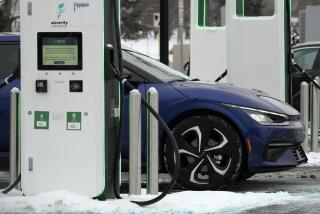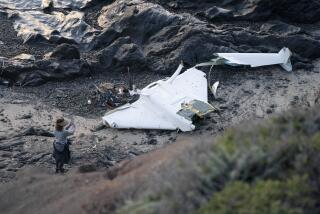Sempra Energy gets FAA approval to test drones for San Diego utility
The Federal Aviation Administration has cleared San Diego company Sempra Energy to begin testing drones for possible use in inspecting electric and gas lines in remote or hard to reach areas.
Sempra’s San Diego Gas & Electric is the first utility the federal government has authorized to use the unmanned aircraft technology, the company said Friday in a statement. Sempra plans to test the drones — small remotely controlled helicopters — in an unpopulated area of eastern San Diego County. If successful, the utility hopes to use them for locating the causes of power failures.
The aircraft, known as a quadcopter, is made by Massachusetts company Physical Sciences Inc. and weighs less than a pound. It is 16 inches in diameter, with four propeller rotors attached to a central hub. A small camera attached to the hub sends images to a base station on the ground.
“It looks similar to the hobbyist model,” David Geier, vice president of electric transmission and system engineering at the utility, said Friday. But he said it’s a bit more sophisticated and will have an infrared camera that can be used to identify hot spots in power lines.
Drones have been used extensively by the military over the last decade and more companies are seeking to put them to commercial use.
Last month, the government authorized the first commercial use of drones over land for surveying British Petroleum’s oil fields on Alaska’s sparsely populated North Slope. On Wednesday, Amazon.com Inc. petitioned for an exemption from FAA rules that has kept the online retailer from testing its experimental drone delivery system, dubbed Amazon Prime Air, outdoors.
The FAA also recently issued guidance to model aircraft hobbyists, warning them not to use the devices for commercial purposes, such as real estate agents taking aerial photos of properties they are trying to sell.
Sempra says it will investigate the use of the small drones in its day-to-day operations as a tool to improve inspections of its networks in areas that are hard to reach by road or helicopter. The drones could also reduce the company’s costs and provide a more environmentally friendly alternative to noisy helicopters and heavy equipment.
A pair of quadcopters and the base station cost about $6,000, Geier said, whereas a helicopter can cost $2,000 an hour to operate.
As part of the FAA approval process, the utility worked out a testing protocol that involves using restricted airspace in four 2.5-mile test areas about 30 miles east of San Diego, as well as a zone at a training facility in San Diego that is 100 yards in diameter.
The unmanned aircraft will be operated by a licensed private pilot, Geier said, and the utility must file a flight plan when it flies them. Greier said that by demonstrating the benefits of the drones and SDG&E’s ability to use them safely and effectively, he hopes to persuade the FAA to allow the utility to expand the areas where they are used.
“We really see it as the door cracked open,” Geier said.






